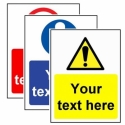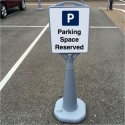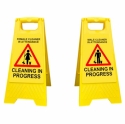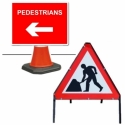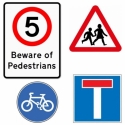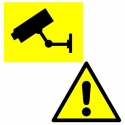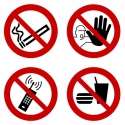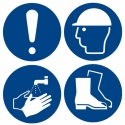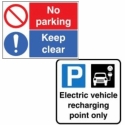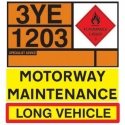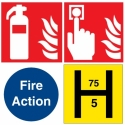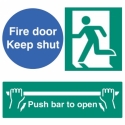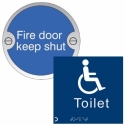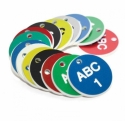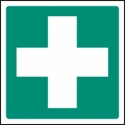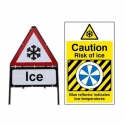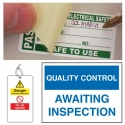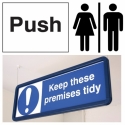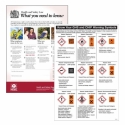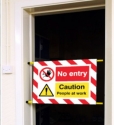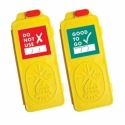Safety Signs
Over 6,000 road, fire and safety signs - many available on a next working day basis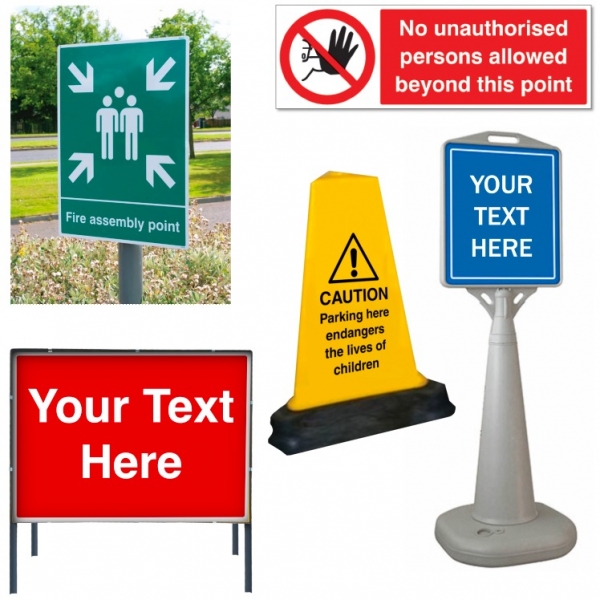
Service Levels on Signs
- All the standard safety signs shown here are available on a next working day basis if ordered before 3pm.
- Our range of road signs usually take 1-2 working days to be dispatched
- Finally, once artwork is agreed, our bespoke, custom-made signs usually take around 2 working days to be delivered.
When selecting your sign, please consider the following material guidance:
- Select Self-adhesive vinyl if the sign is to be installed on to a smooth, flat, clean surface.
- Select Rigid Plastic if you wish to affix the sign to almost any surface.
- Select Photoluminescent Rigid Plastic if you wish the information to be read should the lights fail in the event of an emergency.
- Select Aluminium if the sign needs to be hard wearing and long lasting – particularly if it to be used outside
Can't see the sign you need? We stock over 7,000 standard signs and can make bespoke one-off signs. Call us today on 0161 413 7939 for a quote - we will beat any like-for-like quote.
SAFETY SIGNS OVERVIEW
Safety signs installed in workplaces, construction sites and all other public areas are governed by The Health and Safety (Safety Signs and Signals) Regulations (1996). This piece of legislature combines the different standards from the UK and Europe, and attempts to ensure that all workplace risks are kept to a minimum.
These regulations require employers to ensure that any 'significant' risk to health and safety 'that is not controlled by other methods' is clearly signed. The way the HSE defines a risk is anything brought up through a risk assessment or permit to work under the Management of Health and Safety at Work Regulations 1999 (the Management Regulations). It does also specifically say that signage is NOT a substitute for more comprehensive (or expensive) risk control methods. As a rule of thumb, if it is not reasonable for you to minimise the risk any further, then it is a good idea to demark with the correct signage. In short, signage is to be used as an additional means of accident prevention, rather than the sole method. The exception to this rule is fire signage, some of which must be displayed, regardless of the apparent risk.
An employer is also responsible for the health and safety aspect of installing signs. This means that you must ensure that all signs are mounted securely and do not pose a real threat of injury to any person or person's property. It is for this reason SSP have a wide range of sign fixing options for larger, heavier signs, and also some more lightweight materials to help avoid any issues of this nature. This is also the reason that any aluminium signs supplied with channelling for post mounting are supplied with rounded edges. This helps ensure that in the event that somebody does collide with a sign (Which should be out of reach in the first place), they will not be at risk of such a serious injury.
The final responsibility an employer has with regard to safety signage is ensuring that all signs are understood. Whilst most of the signage seen day to day is fairly self explanatory, some more obscure pictograms may be confusing to younger people, or people outside a specific industry. It is for this reason that employers have a responsibility to provide information and training, and/or provide supplementary text on their signage. It is worth noting that text should be kept as brief as possible. It is down to the management to deem what is 'reasonable precautions'. This may involve using multiple signs, pictograms, or even languages, for example in Wales.
The law also does its part to ensure comprehension. Two standards exist to try to create harmony with regard to safety signs. It is advised that ISO 7010 is the starting point. If BS EN ISO 7010 does not cover a specific pictogram, management should refer to BS EN 5499
BS EN 5499
The first standard has now been superseded, however many of its core points shaped the signs that we see today. For example, the standard created a platform for safety signs, dividing them into six easily recognisable groups;
Prohibition (Red Pantone 186) - These signs disallow activities that may be detrimental to health and safety, for example a 'No Entry' safety sign
Warning (Yellow Pantone 116) - These signs forewarn against potential hazards, such as a 'Caution Wet Floor' Sign
Mandatory (Blue Pantone 300) - These signs inform actions that MUST be taken, for example 'Eye protection must be worn'
Safe Condition (Green Pantone 370) - These signs indicate safe areas and routes to assist in the event of fires or emergencies. The most common example would be the 'Fire Exit' sign
Fire Equipment (Red Pantone 186) - Indicate areas with equipment for tackling small fires, such as fire blankets or wet risers.
Supplementary Information (As relevant) - Provide directions or additional instructions alongside the signs above.
Another part of the standard that has remained is the colour scheme. In order to minimise confusion, the colours used in the signs above, as well as motorway and other road signs should conform to the standards shown here - https://www.gov.uk/guidance/traffic-sign-images. This requires that all colours should be specifically matched using the codes above. It is worth noting that all of SSP's safety signs, off the shelf or bespoke, are borne out of these specific industry standard colours and pictograms. Again, to minimise confusion, safety signs should use a font that is easy to understand. All of SSP's safety signs use the Helvetica font, which is famed for its legibility, both in light and dark contrasts.
BS5499 also guides the best practices with regard to lighting. Where fire exit signs are concerned, it is generally acceptable to use a good quality photoluminescent sign rather than a more expensive illuminated sign. There are exceptions to this rule however. Places with routinely dimmed lights (Such as theatres, cinemas and night clubs) should utilise lights alongside signage, to ensure visibility at all times. Photoluminescent signs MUST be at least Class C rated, meaning that they have high performance under low lighting conditions.
The other major part of BS5499 which has maintained is sign sizing. The regulations state that 'Signs should be sufficiently large and clear so that they can be easily seen and understood ' This, of course, is open to interpretation, however as a guide, please see below for common non photoluminescent Fire Exit sign sizes based on viewing distance;
Distance up to 10m – 300x100mm
Distance up to 20m – 600x200mm
Distance up to 40m – 1200x400mm
As photoluminescent signs are generally easier to see from a distance, they can arguably be smaller. Again, as a rough guide please see below
Distance up to 17m – 340x120mm
Distance up to 22m – 400x150mm
Distance up to 30m – 450x200mm
Again, these sizes are a rough guide and will vary dramatically from place to place, depending on lighting and the nature of the room.
One lasting effect that BS5499 has had is the text attached to Fire Exit signs. The standard's successor suggested pictogram based signage throughout the industry, however comprehension testing showed that adding the words FIRE EXIT meant that 100% of people tested could understand its meaning, in line with ISO 9186 (Comprehension Testing Standard).
BS EN ISO 7010
As the world becomes a more diverse place, there are a growing number of people who live and work in a country whose first language is not their own. To combat this, the ISO 7010 standard was introduced. This harmonises pictograms (Shown here https://www.iso.org/obp/ui/#iso:pub:PUB400004:en) in an attempt to make signs understandable, even to those who cannot necessarily read the supplementary text. Currently, ISO 7010 is adopted by the following countries as of January 2013; Austria, Belgium, Bulgaria, Croatia, Cyprus, the Czech Republic, Denmark, Estonia, Finland, the Former Yugoslav Republic of Macedonia, France, Germany, Greece, Hungary, Iceland, Ireland, Italy, Latvia, Lithuania, Luxembourg, Malta, the Netherlands, Norway, Poland, Portugal, Romania, Slovakia, Slovenia, Spain, Sweden, Switzerland, Turkey, and the United Kingdom.
ISO harmonised symbols is not a new thing. Here is (a quite funny) infographic from the International Standards Organisation that shows how ISO symbols already helped us before 2013 - https://www.iso.org/iso/graphical-symbols_booklet.pdf
Introduced in 2003 and updated in 2011, it is likely that most of the signage you see today will be compliant with the new standard. For this reason, all of SSP's safety signs now use pictograms from ISO 7010. It is best practice to avoid mixing the two sets of symbols, so if your workplace already has a large number of the older style, it may be worth giving us a call to arrange a personalised sign using old symbols. Remember these standards are not law. They are codes of practice designed to minimise confusion, not to break the bank! Again, it is your responsibility to ensure that employees are aware of the meanings, so if you do make the switch, it is a good idea to implement some degree of training.
This idea of harmonising was mirrored by the Classification, Labelling and Packaging of Chemicals (Amendments to Secondary Legislation) Regulations 2015 (CLP). This introduced a Globally Harmonised System (GHS) for labelling and classifying chemicals. As of the 1st June 2015, the former standard (CHIP) was superseded by the United Nations' new GHS. This means that chemicals can be easily identified by natives, visitors and even when sent elsewhere in the European Union.
The CLP is not to be confused with ADR regulations, which determine what codes, symbols and information should be displayed on vehicles carrying potentially hazardous loads. These signs inform traffic officers and other public services what to do in the event of an accident involving hazardous materials. Further information can be seen here - https://the-ncec.com/free-online-hazmat-hazchem-guide/#ADR If you are not sure which codes, symbols or information to include, feel free to give us a call or send an email and we'll do our best to work out the correct content for your sign.
Regulatory Reform (Fire Safety) Order 2005
The other piece of law that an employer needs to be aware of surrounds fire safety. The Fire Safety order states that an employer is responsible for ensuring safety in the event of a fire. They can do this by performing regular fire risk assessments and ensuring the following criteria are met;
1. Fire exits must be clear, clearly marked and unlocked. This means that nothing should be stored in the way of fire escape routes, and the door should be operational without any specific training. Areas near fire exits should also be kept clear of any flammable materials. It is also worth mentioning that in the case of access controlled doors, any magnetic locks must be complete with an emergency override button, to be used in case of emergency. These can also be linked to manual fire alarm systems to provide a warning at the same time.
2. Normally, if there is only one route of escape, the door or protected stairway should be no farther than 18 metres from the farthest point in the room for more hazardous areas where fire could spread rapidly or start easily. This distance is increased to 25m for 'safer' areas. If there is more than one route, the distances should be no farther than 25 or 60 metres respectively. These high risk areas should not generally open directly onto a protected area.
3. When performing a fire risk assessment, it may be apparent that certain rooms or floors may not be aware of a fire elsewhere in the building. For these circumstances, it would be necessary to install an fire alarm system, complete with call point and autonomous fire detector.
4. Fire extinguishers should be provided where necessary, complete with Extinguisher Identification signs. These are not in place to help fight a fire, rather to help create a safe escape route if and when necessary. It would be wise to inform all staff of this. Whilst not a legal requirement, your risk assessment may indicate that fire extinguishers may help in the event of an emergency.
Conversely, it may become clear that fire extinguishers would make the building more at risk of vandalism, specifically in the case of empty or unstaffed buildings.
5. Signage. As part of a risk assessment, fire action notices are vital. These signs are in place in every public building in the country, and could genuinely be the difference between life and death in the case of an emergency. These signs tell the reader exactly what to do, and what not to do, in the event of a fire. They also inform the reader of the dedicated assembly or muster point. It isn't required, however a map of the building placed next to a fire action plan is a good idea for buildings with high levels of new visitors who are unfamiliar with their surroundings. Fire exit signage should also be used properly. Fire exit signage should minimise confusion and guide people to the nearest fire exit as quickly as possible. It is recommended to ensure that all fire escape routes can be seen even in low light, so it is a good idea to use illuminated or photo luminescent fire exit signage. A fire exit door should be marked with a Final Fire Exit sign. Fire doors must be complete with Fire Door Keep Shut signs (White on Blue), and double doors should have the sign on both sides.
Refuge points should also be clearly marked. Refuge points are areas where less mobile people, wheelchair users, children, or those unable to access fire escape routes can safely remain for a short time until the fire warden or other responsible member of staff can assist them out of the building. Since using a lift in the event of fire is not a good idea at all, safe refuges should be in place on every floor. These safe areas are usually found in stairwells, and are complete with a steady supply of clean air, as well as being protected from smoke infiltrating the area. These areas are normally protected by fire retardant walls and electrical measures.
Once out of the building, if the assembly point cannot be immediately seen, the management has a responsibility to provide guidance so that evacuees are able to get to the safe muster point in as timely a fashion as possible. It is advised that assembly points are placed twice the height of the building away, in a safe area as free from risk as possible. Where multiple muster points are in place, you should direct to the nearest point from any given exit.
For further reading, see a more in depth guide to the Fire Safety Order, authored by Bristol University here - https://www.bristol.ac.uk/safety/media/gn/escapesigns-gn.pdf
Another piece of legislation worth mentioning is the Health Act 2006 – more commonly known as the Smoking Ban. If your premises has more than one employee (Full or part time) or could possibly be visited by a customer, it is unlawful to smoke tobacco (Or anything else) inside. As such, businesses must install no smoking signs in all work premises and vehicles. Smoking is permitted (At the company's discretion) in company vehicles only used by one person, and the smoking of e-cigarettes or vaporisers is again the decision of management. The one exception to the Health Act is residential homes, however they must ensure a separate space which does not 'leak' in to the rest of the building.
As a rule, it is best to try to avoid thinking about the legal side of safety signs. The intent behind all of the above legislature, guidance and standards is to keep you, your employees and your visitors safe, so when installing signs, try to maintain a safety conscious mindset. If you are in doubt, give us a call and SSP will happily advise on best practices.
If you'd rather, there are multiple organisations that are able to help advise on this kind of safety issue, such as ROSPA (https://www.rospa.com/) and the HSE (https://www.hse.gov.uk/workers/employers.htm). Local fire services also operate a free fire safety check on request (https://www.fireservice.co.uk/safety/hfsc)
ROAD SIGNS >>>
Since SSP was first established in 1999 much has changed in the world of road signs. Road signs (along with road paint and thermal marking) in the UK are regulated by The Traffic Signs Regulations and General Directions 2002, and further guidance is provided by the government in the form of Traffic Advisory Leaflets and the Traffic Signs manual. All of these documents can be found on the government website https://www.gov.uk/government/collections/traffic-signs-signals-and-road-markings
Critics argue that the road sign regulation in the UK today is too complicated and too focused on legality, rather than safety, which is the purpose of the law after all. For this reason, the government have proposed a draft of the 'overhauled' regulations, which can be seen here (https://www.gov.uk/government/uploads/system/uploads/attachment_data/file/307152/draft-tsrgd-schedules.pdf) This revised document aims to do away with the 'red tape', allowing local authorities to decide what they deem appropriate in terms of signage. It also intends to make signage less distracting and generally more useful to the road user.
Argument one is that signs are too readily and blindly put up without thought for their purpose. This could be extremely dangerous. On every road in the UK, drivers must stay on the left hand side. If, however, you place a keep left sign (Diagram 610) on every stretch of road, it would remove the urgency when the sign is warning of a genuine danger. This is, of course, exaggerated, though perhaps not as silly as you might think. (https://www.mirror.co.uk/news/uk-news/stupid-signs-to-be-scrapped-under-new-1433428)
The reschedule also allows for more freedom for local authorities. Firstly, the draft allows the installation of signs without the need for illumination. Naturally, there are exceptions (Mainly speed, give way and other vital safety road signs) and councils must think before installing. However for the most part, simply using a good quality Reflective aluminium material is enough to fulfil the legal side of things, as well as being highly visible under vehicle headlights. The draft actually calls for all traffic signs to be reflectorised using high quality reflective material.
This does beg the question, which grade of reflectivity should be used? Again, it is down to the local authority to deem what is appropriate, however as a rough guide, RA1 (formerly Class 2) reflective should be used on side roads and R2 (formerly class 1) aluminium would be used on more major roads. With reflective lifespans of five and ten years respectively, these materials should ensure that your signs are easily visible and able to stand the test of time.
The industry leading reflective material is known as Diamond Grade. This is a solid, rigid sheeting which is most commonly used on vehicles in line with ECE 70, but is also used for larger motorway signage and other areas which need guaranteed high levels of reflectivity over time.
One change that the average road user may notice is the switch on weight and height limit signs. Before, signs warning of height and weight restrictions were bound to either metric or imperial. In order to make the signs more universally understandable, the draft means that all new signs and replacement signs of this nature will display both metric and imperial units. This is part of an initiative, in line with safety signs, which unifies symbols and signage across Europe
These updated regulations allow a local authority (for reasons not including environmental or financial benefits) to use different sizes than those rigidly set out in the 2002 version. For example, the pedestrian crossing (Figure 544) sign may need to be placed in a limited area. As the sign warns of a zebra crossing, which is quite visible from a distance, it is perhaps not entirely necessary to go to the effort of fitting oversized warning signs where they do not necessarily fit. Conversely, there may be a need for a larger sign than usual. For example a country road with a school may wish to use more prominent signage than usual for safety reasons.
One area of change in the regulations is the No Entry sign (Diagram 616). The changes make it unlawful to use this sign without a traffic order, which helps determine where there is a genuine safety risk and what is simply a private road. It also allows for additional supplementary messages, with no entry, including 'buses', 'taxis', and 'cycles'.
There is also a completely new road sign added in the schedule. Diagram 956.2 has been included for routes used by bicycles, pedestrians and horse drawn vehicles only. While this is a welcome addition to the law, it may have proved useful not to stop there when adding additional signs (https://www.dailymail.co.uk/news/article-2509417/The-signs-London-taxi-drivers-like-see.html)
The general idea is to minimise the regulation in road sign, and rely more on guidance. Using proper research and risk analysis, a local council can drastically reduce the risk of dangerous occurrences simply by using the right sign, and hopefully these changes will help as well. This power given to authorities does also come with responsibility, however. Local councils are now expected to determine whether signs, markings and regulations are displayed clearly enough to be enforceable. The installation of multiple signs is no longer as tightly governed, and it is now the council's job to ensure that all signs fulfil the purpose for which they are intended. Generally, this means parking signs, however the same is true for restricted stopping and waiting areas, as well as outside schools and loading bays. As mentioned previously, the red tape is removed somewhat; the need for a traffic order is no longer necessary when placing a 'no stopping on entrance markings' sign. It also allows for non permit parking in permit areas, by the use of the legend 'Except in signed bays'
As well as slight changes to parking regulations, a few new symbols have also been added. New symbols allow for signage related to electric vehicle charging, red route and car club parking schemes. (An excellent description of car club parking by Southwark Council https://www.southwark.gov.uk/info/100011/transport_and_streets/1378/car_clubs)
There is also a new sign that allows for contra flow cycling (Figure 960.2)
There is also a slight change to the 'No motorised vehicles sign' (Figure 618.2), which is now 'Pedestrian and cycle zone' so as not to be confused with 'no vehicles'. Quite usefully, circular prohibition symbols can now be installed with more in depth supplementary plates, allowing for exceptions, time limits, specific instructions and so on.
Again, in an effort to combat red tape, a council is now permitted to simply use contrasting colours to mark parking bays, rather than specifically detailing sizes and colours of lines. This seems like a big step forward in making signage do the job it is designed for. Alongside this, the restrictions on upright (Post Mounted) signs for loading and parking bays have been relaxed, meaning that it should be more difficult for a council to uphold a penalty from loopholes. On balance, the schedule does specifically say 'Traffic authorities are encouraged to take a pragmatic approach to enforcement in cases where larger vehicles could not be fully accommodated within an appropriate parking bay or space, implying the changes are for the purpose of ease and understanding, rather than simple fine or penalty enforcement.
Where speed limit signs are concerned, there are many changes. The refresh relaxes the need for repeater signs.
One change that all drivers will be happy to see is the regulation surrounding 20mph zones. The changes allow a local authority to enforce a 20mph zone without the need for excessive traffic calming measures. This means that councils will be more inclined to drop the limit on more dangerous roads, and road users (And their suspension) do not have to suffer as a result.
Interestingly, it makes diagram 670 (speed limit) legally allowed above a motorway, as opposed to by the side of the road. This implies that the managed motorways scheme was unlawful up until this point, which highlights the need for refreshing legislation such as this periodically. Anyone who has used a managed motorway will probably agree that while not ideal for speed, having regular, variable speed limit reminders is a great safety feature of any motorway, which will hopefully help avoid countless accidents in the future. Motorways will now also benefit from updated figures 873, 874, 875 and 876. These signs (Indicating exits or junctions) may now be more specifically tailored to the junction in question, helping limit confusion for non local drivers and hopefully minimising accidents from drivers who notice at the last second that they should already be in the lane to the left.
Quieter roads also benefit from the update. As well as a new sign for Quiet Lanes (England only), there is a new sign (Similar to figure 820) which warns of lanes unsuitable for larger vehicles, who often get into bother by relying too heavily on satellite navigation systems.
One change that may be quite confusing to people who have been driving for a long time is also noted. The lane markings in the centre of a road will no longer be related to the road's speed limit, and will be more geared towards safe overtaking areas. Another change that you may have already noticed is the introduction of the 'Yellow Box' on approach to a major roundabout. This is a welcome addition that should help combat congestion on busier roads, as well as helping to avoid collisions.
Marketing has also been mentioned in the regulations. For example, a cycle scheme logo may now be used alongside cycle routes, and as you may have noticed, corporate logos are now permitted on motorway service stations. This is, of course, assuming the franchise operates in the service station and not just for advertising purposes.
As well as road signs, the TSRGD 2015 now incorporates the Zebra, Pelican and Puffin Pedestrian Crossings Regulations 1997. All existing crossings will remain in force, however Pelican crossings have been removed, meaning that new pelican crossings can no longer be placed. The regulations also allow for additional indicators for pedestrians and allow for 'Pedestrian Countdown', which counts down the 'blackout' period between a solid green figure and the red figure. The update also consolidates the zig zag markings, meaning that all crossings of this nature must have eight zig-zag road markings, with the flexibility to use two if the layout or character of the road makes it relevant.
Cyclists are, quite unsurprisingly, mentioned frequently in the refresh. With more and more people choosing to cycle rather than drive, serious thought was needed in order to keep them safe. Councils are now permitted to fit convex safety mirrors (Between 300-500mm) in order to allow large vehicles more awareness of cyclists in their blind spot at a junction. Traffic signals for cyclists are also prescribed, including an 'early start' signal, which allows cyclists time to pull off before vehicles, minimising the danger of being hit by impatient drivers. The regulations now also allow for 'Elephant's Footprints', which are 250-400mm square road markings to indicate a cyclist path through a signal controlled junction.
It is perhaps worth mentioning that these changes were intended for implementation in March 2015, however as of today (December 2015) they are still not passed before Parliament, and in the 'draft' stage.
With regard to temporary road signs, not much has changed. There is now an allowance for the use of road studs to indicate road markings in temporary situations, and all road works will be demarked by the Men at Work symbol 7001, along with supplementary sign 7001.1. For a more detailed look at permitted road works signs, see here - https://www.legislation.gov.uk/uksi/2002/3113/schedule/12/part/I/
The lack of change in regulations for road signs is unsurprising. This is because the validity of temporary road works signs is generally determined by the Guidance document Traffic Signs Manual Chapter 8 (2009) - https://www.gov.uk/government/uploads/system/uploads/attachment_data/file/203669/traffic-signs-manual-chapter-08-part-01.pdf Outside of Northern Ireland, this document has no statutory force, however it does provide guidelines that allow people to operate legally in a wide set of circumstances, namely protecting traffic authorities from non-compliance with Section 16 Traffic Management Act 2004.
The first part of a legal road sign is font. All road signs, temporary or otherwise, should use the Transport font. Transport Heavy (Bold) is used on lighter backgrounds and Transport Medium is used in darker backgrounds, to assist with legibility. This font has since been adopted by the Gov.uk website due to its clear, easy to read nature. The Transport font should not be confused with Helvetica, the standard font on safety signs.
Again, the materials used in temporary situations are similar to the fixed road signs. Most freestanding road works signs use RA1 reflective, however it is the responsibility of the user to ensure that the signs are sufficiently visible, so in low light areas it is recommended to use R2 prismatic reflective. These reflective fascias are layered over 20/22 guage Zintec. Zintec is a lightweight, low cost steel which is electro coated in order to prevent corrosion from weathering.
Temporary sign frames from SSP are also constructed from steel, with a water based acrylic coating for weathering protection. This means that the road signs are sturdy, whilst perfectly capable of being moved by one person. The nature of the steel construction means that in the event of an accident with a vehicle, the sign and frame will cause minimal damage. This combination of steel, paint and reflective sheeting also helps minimise the risk of scrap theft.
The next thing to think about is size. There are some quite detailed size guidance notes in Chapter 8. Where temporary signs are concerned, size is directly related to the speed limit of the road that they will be used on. For example, temporary speed limit signs should be as follows:
Dual Carriageway (National Speed Limit) – 1500mm Diameter
Dual Carriageway (50-60mph) – 1200mm Diameter
Single Carriageway (50mph+) - 900mm Diameter
Other Roads (40mph) – 750mm Diameter
Other Roads (30mph or less) – 600mm Diameter
These sizes vary based on the type and shape of sign, so give us a call if you are unsure and we will point you in the right direction. Our sales team are trained thoroughly on all product ranges, and are happy to advise or guide you as necessary. While our web team are working hard to ensure our offering is as complete as it can be, the sheer size and ever evolving nature of road signs means that it would be impossible for everything to be shown online.
All of our signs are available on a 1-2 day basis, and if you give us a call before around 2pm, most items can be available next day. We are also able to make bespoke signage using our in-house printing facilities, meaning that we can create personalised or amended signs often at little or no extra cost. As per the Welsh Language Act 1993, we can also make dual language English and Welsh signs, however we would need you to provide a translation. Finally, if you would like signs showing any other language, if you can supply the text, we can also print these to your exact specifications.
Please bear in mind that behind the website is a friendly, knowledgeable, Manchester based team who are happy to help. If you cannot see what you are looking for, feel free to email, call or live chat (9am-5pm using the red tab shown right)




 2,634 reviews
2,634 reviews



